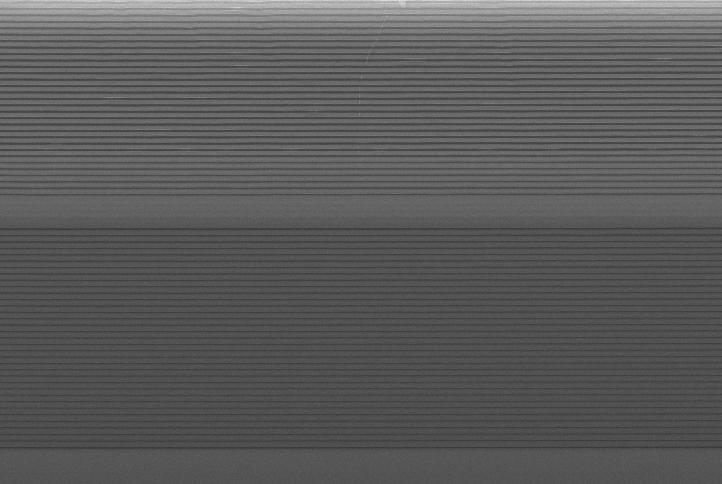Scientific directions
Semiconductor heterostructures & nanostructures
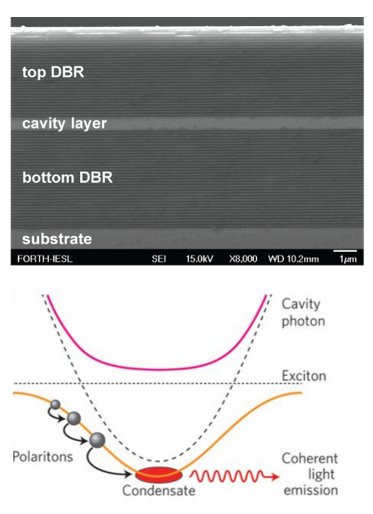
Semiconductor microcavities are nanostructures grown by Molecular Beam Epitaxy, which consist of either GaAs or InGaAs Quantum Wells embedded between two Bragg mirrors forming a planar Fabry-Perot cavity. In such structures, exciton polaritons result from the strong coupling between a resonant optical cavity mode and a confined excitons. The bosonic nature of exciton polaritons inherited from their light–matter composition is responsible for observations of stimulated scattering, amplification, condensation and lasing of polaritons. In contrast to conventional lasing, where coherent light emission is driven by stimulated photon emission, polariton lasing is achieved through the stimulated scattering of polaritons and the formation of a condensate without the need for population inversion. More...
Therefore, polariton lasing promises two orders of magnitude lower threshold than conventional photon lasing and a new generation of ultralow threshold laser devices. In addition, polariton condensates have been shown to exhibit similarities to atomic Bose–Einstein condensates (BECs), displaying a spontaneous build-up of long-range spatial coherence and a thermalized distribution within the population. Unlike atomic BECs, polariton condensation can be achieved at high temperatures due to the very small polariton effective mass. Major prerequisite to all the above observations is the ability to fabricate state of the art MBE grown high finesse microcavity structures allowing very long polariton lifetimes capable of supporting efficient relaxations of polaritons to the ground state and formation of condensate. Other important challenges include growth of p-i-n diode microcavities for efficient electrical injection of carriers while preserving finesse of the grown structures. Quantized polaritons without condensation, P Cristofolini, Z. Hatzopoulos, PG Savvidis, and JJ Baumberg, Phys. Rev. Let. 121, 067401 (2018) An attojoule electrical spin-switch based on optically trapped polariton condensates, A Dreismann, H Ohadi, Y.V.I. Redondo, R. Balili, Y Rubo, S.I. Tsintzos, G. Deligeorgis, Z. Hatzopoulos, P.G. Savvidis, J.J. Baumberg, Nature Materials 15, 1074 (2016) Strong coupling and stimulated emission in single parabolic quantum well microcavity for terahertz cascade, A Tzimis, A.Trifonov, G Christmann, SI Tsintzos, Z Hatzopoulos, I Ignatiev, AV Kavokin, PG Savvidis, Appl. Phys. Lett. 107, 101101 (2015) A GaAs polariton light-emitting diode operating near room temperature, S. I. Tsintzos, N. T. Pelekanos, G. Konstantinidis, Z. Hatzopoulos, P. G. Savvidis, Nature 453, 372 (2008)Participating members: Pavlos Savvidis, Simeon Tsintzos, Panagiotis Tsotsis, Peter Eldridge, Pramod Kumar Sharma, Stefanos Chatziathanasiou, Alexandros Tzimis, Giannis Paschos, John Balas, Iliana Harkoutsaki, Nikolaos Pitanios , Dimitris Kavalieros
Nanophotonics
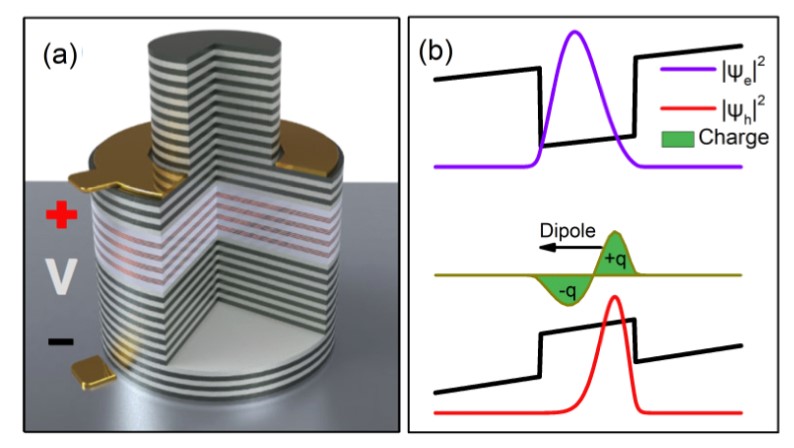
The realization of strongly interacting photonic systems is one of the holy grails of quantum optics. Achieving the nonlinear quantum regime in photonics where the single-site effective photon interaction energy is larger than the losses, opens a plethora of interesting phenomena such as photon blockade, photon crystallisation, and opportunities to realize quantum simulators for the study of condensed matter problems such as Mott-insulator to superfluid phase transitions in arrays of optical cavities. In solid-state cavity-polariton systems consisting of a cavity photon and a quantum well exciton, dominant direct exciton interactions originate from short-range exchange terms. These interactions have led to the manifestation of a number of intriguing collective phenomena, including formation of spontaneous coherence. Very recently, photon correlation measurements on strongly confined polaritons have demonstrated weak quantum correlations. Increasing polariton-polariton interaction further is crucial to exploring a new regime of strongly correlated photons. One way to enhance interactions is to engineer polaritonic excitations with a permanent dipole moment. Here, we demonstrate electrical tuning of nonlinearities in exciton-polariton condensates. More...
Enhance polariton-polariton interactions are obtained using wide QWs in an electrically driven MC by exploiting the quantum confined Stark effect (QCSE) to form dipolar polaritons and demonstrate tuning of the exciton-exciton interaction. As a direct consequence of this, we obtain enhancement of the polariton emission in both linear and lasing regimes with a simultaneous reduction of the polariton lasing threshold and shorter polariton condensate formation times due to enhanced exciton scattering. Such controlled enhancement of exciton interactions, are expected to provide the new route to realization of non classical light sources relying on polariton quantum blockade. Electrical tuning of nonlinearities in exciton-polariton condensates, S.I. Tsintzos, A. Tzimis, G. Stavrinidis, A. Trifonov, Z. Hatzopoulos, J.J. Baumberg, H. Ohadi, P.G. Savvidis, Phys. Rev. Lett. 121, 037401 (2018) Tuning the Energy of a Polariton Condensate via Bias-controlled Rabi Splitting, P. Tsotsis, S. I. Tsintzos, G. Christmann, P.G. Lagoudakis, S. Kyrienko, I.A. Shelykh, J.J. Baumberg, A.V. Kavokin, Z. Hatzopoulos, P.S. Eldridge and P. G. Savvidis, Phys. Rev. Applied 2, 014002 (2014) Coupling Quantum Tunneling with Cavity Photons, P. Cristofolini, G. Christmann, S. I. Tsintzos, G. Deligeorgis, G. Konstantinidis, Z. Hatzopoulos, P.G. Savvidis and J.J. Baumberg, Science 336, 704 (2012)Participating members: Pavlos Savvidis, Panagiotis Tsotsis, Peter Eldridge, Alexis Askitopoulos, Pramod Kumar Sharma, Stefanos Chatziathanasiou, Manolis Χypakis
Prototype polaritonic devices
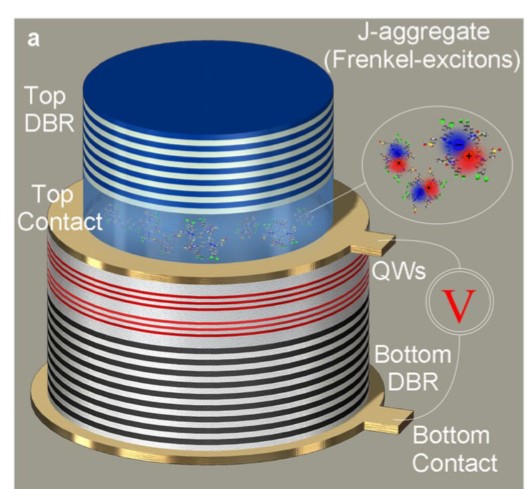
Hybrid polarion laser Organic materials exhibit exceptional room temperature light emitting characteristics and enormous exciton oscillator strength, however, their low charge carrier mobility prevent their use in highperformance applications such as electrically pumped lasers. It has been suggested that combining organic and inorganic semiconductors in a hybrid microcavity, exploiting resonant interactions between these materials would permit to dramatically enhance optical nonlinearities and operation temperature. More...
Here, we study cavity mediated hybridization of GaAs and J-aggregate excitons in the strong coupling regime under electrical injection of carriers as well as polariton lasing at near room temperature under nonresonant optical pumping. Such hybrid organic-inorganic structures, combine many desirable properties such as large exciton Bohr radius, favouring polariton-polariton interaction and relaxation as well as large oscillator strength for room temperature operation. Our experiments pave the way towards realization of hybrid organicinorganic microcavities which utilise the organic component for sustaining high temperature polariton condensation and efficient electrical injection through inorganic structure. THz polariton bolometer device Bolometers are well-known for their ability to detect electromagnetic radiation by absorbing energy and measuring associated temperature changes. The main drawback is their limited sensitivity compared to more expensive cryogenically cooled systems. As applications of THz technologies are becoming more common place, the development of future THz detectors, such as antenna-coupled bolometers and graphene-based devices is gaining ever increasing interest. In a seemingly separate area of research, semiconductor microcavities with quantum wells create a fusion of electronic and optical properties in the form of exciton-polaritons. While traditionally studied for their fundamental effects, these quasi-particles have demonstrated a number of properties useful for hybrid electro- optic devices: direct coupling to both electric and optical fields, fast-response times, long coherence lengths/times, and strong nonlinearity as compared to typical nonlinear optical materials. A variety of theoretical studies have also identified polaritons as prominent generators of THz radiation, by making use of the bosonic final state stimulation of THz frequency transitions or oscillations between multiple quantum wells. Here we consider polariton based THz detection scheme. In contrast to conventional bolometer schemes, a polaritonic based bolometer sensor couples THz induced thermal variations to a polariton-based signal rather than an electrical output. The long coherency of polaritons enable an additive effect over the device size leading to increased sensitivity. Based on the above constituents, we realize an exciton-polariton based interferometric device utilizing one-dimensional channels to propagate coherent polariton condensates. We experimentally measure the temperature induced changes in the interference of counter-propagating polariton condensates and show that such a bolometer device can serve as a platform for temperature sensing and consequently be adopted for use as a THz radiation detector. Hybrid organic-inorganic polariton laser, G Paschos, N Somaschi, SI Tsintzos, D. Coles, J Bricks, Z Hatzopoulos, DG Lidzey , PG Lagoudakis and PG Savvidis, Scientific Reports 7, 11377 (2017) An exciton-polariton bolometer for terahertz radiation detection, GG Paschos, TCH Liew, Z Hatzopoulos, AV. Kavokin, PG Savvidis, G Deligeorgis, Scientific Reports 8, 10092 (2018) Spin Selective Filtering of Polariton Condensate Flow T. Gao, C Anton , TCH Liew, MD Martin, Z Hatzopoulos, L Vina, P Eldridge, PG Savvidis Appl. Phys. Lett. 107, 011106 (2015) Strong coupling and stimulated emission in single parabolic quantum well microcavity for terahertz cascade, A Tzimis, A.Trifonov, G Christmann, SI Tsintzos, Z Hatzopoulos, I Ignatiev, AV Kavokin, PG Savvidis, Appl. Phys. Lett. 107, 101101 (2015)Participating members: Pavlos Savvidis, Panagiotis Tsotsis, Tingge Gao, Peter Eldridge, Alexandros Tzimis, Gabriel Christman, Giannis Paschos, Manolis Mavrotsoupakis, Nikolaos Pitanios , Dimitris Kavalieros
Quantum Technologies
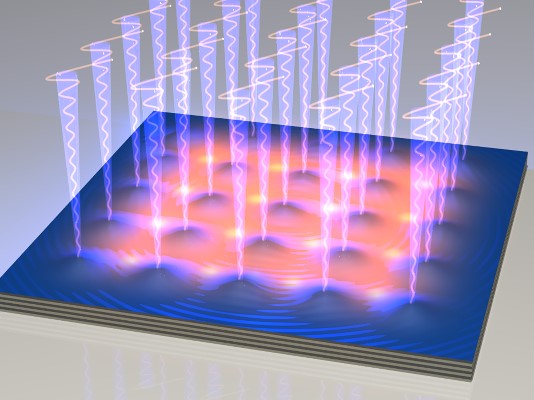
Quantum simulators promise to provide unprecedented insights into physical phenomena not accessible with classical computers and have the potential to enable radically new technologies. Analog dynamical quantum simulators constitute a most promising class of architectures to fulfil the ultimate promise to devise quantum machines outperforming classical computers. More...
Here, we devise versatile and practical platforms for dynamical simulators – making use of polariton condensate lattices and assess their computational capabilities, to probe important questions in fundamental and applied physics, ranging from technology‐relevant problems, concerning transport processes or glassy dynamics, via long‐standing challenges in the physics of non‐equilibrium phenomena. Optical lattices have attracted much attention, since they can replicate phase transition between a BEC and a Mott‐insulating state in a Bose‐Hubbard model. By experimentally modifying physical parameters, such as the periodic potential amplitude, temperature, and density, it is possible to control relative strength between on‐site interaction and hopping amplitude at will exploring the phase diagram of such systems. Such experiments have been of particular interest in the quantum information community since the experiment realizes a nearly ideal quantum simulator. The macroscopic nature of exciton‐polariton condensates provides ease of optical access and probing of individual lattice sites normally not achievable in cold‐atom systems. Furthermore, the non‐equilibrium nature of exciton‐polariton systems is particularly attractive, because it provides the ability to prepare and study out of equilibrium many‐body phases in a natural driven dissipative setting and the ability to probe these phases in situ using optical approaches. Our recent experiments show that individual trapped polariton condensates can exhibit spontaneous magnetization, and that the spins of pairs of trapped polariton condensate can be controllably aligned. This constitutes a key step towards using trapped polariton condensates for the realization of interacting bosons in a driven‐dissipative spinor Bose‐Hubbard model. Hence, a lattice of polariton condensates is expected to model a non‐equilibrium interacting spin system with unusual properties. It is against this background that the field of polaritonics has emerged and these exotic objects are not simply an academic curiosity – rather as we discuss below we will use them as the basis for quantum simulators. Synchronization crossover of polariton condensates in weakly disordered lattices, H. Ohadi, YVI Redondo, AJ Ramsay, Z Hatzopoulos, TCH Liew, PR Eastham, PG Savvidis and JJ Baumberg, Phys. Rev. B 97, 195109 (2018) Spin order and phase transitions in chains of polariton condensates, H. Ohadi, A. J. Ramsay, H. Sigurdsson, Y. del Valle-Inclan Redondo, S. I. Tsintzos, Z. Hatzopoulos, T. C. H. Liew, I. A. Shelykh, Y. G. Rubo, P. G. Savvidis, and J. J. Baumberg, Phys. Rev. Lett. 119, 067401 (2017) Tunable magnetic alignment between trapped exciton-polariton condensates, H. Ohadi, Y.V. Redondo, A. Dreismann, Y.G. Rubo, F. Pinsker, S. I. Tsintzos, Z. Hatzopoulos, P.G. Savvidis, J.J. Baumberg, Phys. Rev. Lett. 116, 106403 (2016) Spontaneous spin bifurcations and ferromagnetic phase transitions in a spinor exciton-polariton condensate, H. Ohadi, A. Dreismann, Y. G. Rubo, F. Pinsker, Y. del Valle-‐Inclan Redondo, S. I. Tsintzos, Z. Hatzopoulos, P. G. Savvidis and J. J. Baumberg, Phys. Rev. X 5, 031002 (2015)Participating members: Pavlos Savvidis, Simeon Tsintzos, Panagiotis Tsotsis, Konstantinos Daskalakis, Pramod Kumar Sharma, Manolis Mavrotsoupakis, Manolis Χypakis, John Balas, Nikolaos Pitanios , Dimitris Kavalieros
Hybrid Photochemically Etched GaN membrane microcavities
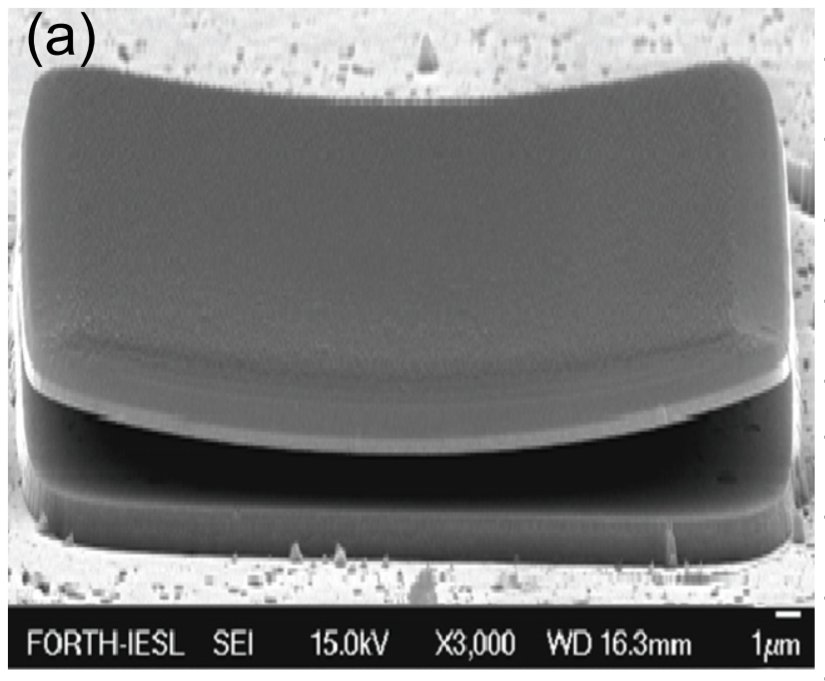
The photonics research activity at the Department of Materials Science and Technology focusses on the study of fundamental properties as well as development of prototype devices utilizing bosonic light-matter quasiparticles called polaritons. The Polaritonics, research field, is a rapidly developing research area extremely rich in fundamental effects and increasingly promising for optoelectronic device applications. One key applications area which we address, is a new type of inversion-less lasers, namely polariton lasers, which rely on the formation of bosonic condensates of exciton polaritons. Such condensates do not require a population inversion and have very low operational threshold. Furthermore polariton condensates can potentially provide a near lossless transfer and manipulation of information that is encoded by light, with the mixed light-matter nature of polaritons creating a direct link between microelectronics and nonlinear optics. The strong light-matter coupling regime and lasing in a GaN microcavity fabricated by incorporating a high optical quality GaN membrane inside an all-dielectric mirror cavity is demonstrated at room temperature. A nonlinear increase of the emission and line narrowing marks the onset of polariton lasing regime with significantly reduced threshold compared with previous reports for bulk GaN microcavity. This combination of low lasing thresholds and ease of fabrication allows incorporation of quantum wells and electrical contacts into the active region, paving the way for electrically driven room temperature (RT) polariton laser devices. More...
All-dielectric GaN microcavity: Strong coupling and lasing at room temperature, KS Daskalakis, PS Eldridge, G Christmann, E Trichas, R Murray, E Iliopoulos, E Monroy, NT Pelekanos, JJ Baumberg and PG Savvidis, Appl. Phys. Lett. 102, 101113 (2013) Bragg polariton luminescence from a GaN membrane embedded in all dielectric microcavity, E. Trichas, N.T. Pelekanos, E. Iliopoulos E. Monroy , K. Tsagaraki , A. Kostopoulos, P.G. Savvidis, Appl. Phys. Lett. 98, 221101 (2011) Resonantly enhanced selective photochemical etching of GaN, E. Trichas, M. Kayambaki, E. Iliopoulos, N.T. Pelekanos, P.G. Savvidis, Appl. Phys. Lett. 94, 173505 (2009) Selective photochemical etching of GaN films and laser lift-off for microcavity, fabrication, E. Trichas, C. Xenogianni, M. Kayambaki, P. Tsotsis, E. Iliopoulos, N. T. Pelekanos, P. G. Savvidis, Phys. stat. sol. (a) 205, 2509 (2008)Participating members: Pavlos Savvidis, Manolis Trichas, Iliana Harkoutsaki
Polaritonic Qubit
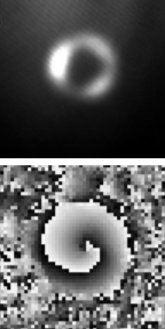
Here at our labs we work on the development of fundamental element of a quantum computer, a polaritonic Qubit. For example it is well known that classical computers rely on encoding information with 0’s and 1’s whereas basic computational operations are made using logic gates. In our Qubits zeros and 1 are represented by liquid light flowing in an annular ring in oposite directions. The total phase accumulated during round trip is magically quantized and is always multiple of 2pi. What is amazing is that we can have superimposed currents of different intensities which can represent all possible mixed states of 0’s and 1’s which can be mapped onto a Bloch sphere. We can arbitrarily prepare and manipulate such states by shaping external laser on the fly. We do this digitally using spatial light modulator by applying computer generated phase masks. Such polaritonic qubits will hopefully serve as the building blocks of the future quantum computers utilizing liquid light. More...
Participating members:
